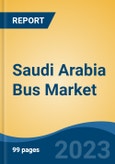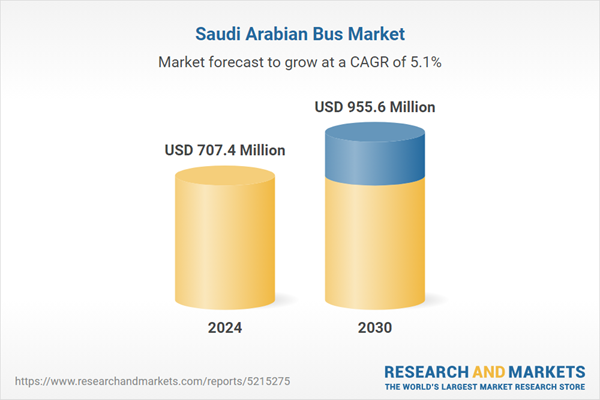Speak directly to the analyst to clarify any post sales queries you may have.
10% Free customizationThis report comes with 10% free customization, enabling you to add data that meets your specific business needs.
The government’s push for green technologies and the development of sustainable transport solutions is driving the shift towards electric buses. Growing demand for efficient public transit and environmental concerns are key factors shaping the market’s future. For instance, In August 2024, Riyadh Air introduced its first electric bus for employee transport, supporting Saudi Arabia’s Vision 2030 to reduce emissions. Developed with National Transportation Solutions Co. and TAM-Europe, the initiative promotes advanced public transit solutions. It merge with the UN’s Sustainable Development Goals. Riyadh Air recently joined the UN Global Compact in 2024.
Market Drivers
Urbanization and Population Growth
Saudi Arabia's rapidly growing population and urbanization are key drivers in the expansion of the bus market. With urban areas such as Riyadh and Jeddah experiencing significant growth, there is a growing need for efficient and reliable public transportation systems. As cities expand, traffic congestion becomes a major issue, prompting the government to invest heavily in public transport infrastructure, including buses.The increasing demand for convenient, affordable, and environmentally friendly transportation solutions drives the adoption of buses for urban commuting. The government’s Vision 2030, which focuses on sustainable development, also prioritizes the improvement of public transport, further boosting demand for buses in cities and towns across the kingdom. Population growth has led to more commuters relying on buses as an alternative to private cars, contributing to the bus market's steady expansion.
Key Market Challenges
High Dependency on Oil Revenues
Despite the push for diversification, Saudi Arabia remains heavily reliant on oil revenues, which can create challenges for long-term investments in sectors like public transportation. Fluctuations in global oil prices can directly impact government spending on infrastructure projects, including bus systems. Although Vision 2030 aims to reduce dependence on oil, it remains a significant part of the economy. In times of lower oil prices, public sector investments, including in transportation, could face delays or budget cuts. This dependency on oil revenues makes the bus market vulnerable to macroeconomic changes and presents a challenge for sustained market growth, especially for the implementation of large-scale electric bus projects or other high-cost infrastructure initiatives.Key Market Trends
Shift Toward Electric and Green Buses
A prominent trend in the Saudi Arabia bus market is the increasing shift towards electric and hybrid buses as part of the country’s broader focus on sustainability. As environmental concerns rise, the government is encouraging the adoption of electric buses to reduce air pollution and lower carbon emissions. Saudi Arabia is beginning to integrate electric buses into public transportation fleets in major cities, which aligns with its efforts to meet climate goals and support green energy initiatives under Vision 2030. Electric buses are becoming more cost-effective as battery technology improves, and their operational costs are lower than those of traditional diesel buses. This trend will likely continue as more investments are made in electric vehicle infrastructure, such as charging stations and maintenance facilities, making electric buses a more feasible option for bus operators.Key Market Players
- Abdul Latif Jameel Commercial Vehicles Co. Ltd.
- Almarai Transport Services Co.
- Aljazirah Vehicles Agencies Co. Ltd.
- International Trucks & Equipment Co. Ltd. (ITECO)
- Binzagr Commercial & Industrial Group
- General Automotive Company Ltd.
- Yutong Bus Co., Ltd
- Zhongtong Bus Holding Co., Ltd.
- Tata Motors Limited
- Hyundai Motor Company
Report Scope:
In this report, the Saudi Arabia Bus Market has been segmented into the following categories, in addition to the industry trends which have also been detailed below:Saudi Arabia Bus Market, By Bus Length:
- Up to 7m
- 7 to12 m
- Over 12m
Saudi Arabia Bus Market, By Fuel Type:
- Diesel
- Electric
- Others
Saudi Arabia Bus Market, By Bus Type:
- City Bus
- Intercity Bus
- Tourist Buses
- School Buses
Saudi Arabia Bus Market, By Region:
- Northern & Central
- Western
- Southern
- Eastern
Competitive Landscape
Company Profiles: Detailed analysis of the major companies present in the Saudi Arabia Bus Market.Available Customizations:
With the given market data, the publisher offers customizations according to a company's specific needs. The following customization options are available for the report.Company Information
- Detailed analysis and profiling of additional market players (up to five).
This product will be delivered within 1-3 business days.
Table of Contents
Companies Mentioned
- Abdul Latif Jameel Commercial Vehicles Co. Ltd.
- Almarai Transport Services Co.
- Aljazirah Vehicles Agencies Co. Ltd.
- International Trucks & Equipment Co. Ltd. (ITECO)
- Binzagr Commercial & Industrial Group
- General Automotive Company Ltd.
- Yutong Bus Co., Ltd
- Zhongtong Bus Holding Co., Ltd.
- Tata Motors Limited
- Hyundai Motor Company
Table Information
| Report Attribute | Details |
|---|---|
| No. of Pages | 85 |
| Published | July 2025 |
| Forecast Period | 2024 - 2030 |
| Estimated Market Value ( USD | $ 707.4 Million |
| Forecasted Market Value ( USD | $ 955.6 Million |
| Compound Annual Growth Rate | 5.1% |
| Regions Covered | Saudi Arabia |
| No. of Companies Mentioned | 10 |









